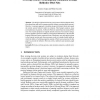Free Online Productivity Tools
i2Speak
i2Symbol
i2OCR
iTex2Img
iWeb2Print
iWeb2Shot
i2Type
iPdf2Split
iPdf2Merge
i2Bopomofo
i2Arabic
i2Style
i2Image
i2PDF
iLatex2Rtf
Sci2ools
ENASE
2009
2009
Evolving System's Modeling and Simulation through Reflective Petri Nets
Abstract. The design of dynamic discrete-event systems calls for adequate modeling formalisms and tools to manage possible changes occurring during system's lifecycle. A common approach is to pollute design with details that do not regard the current system behavior rather its evolution. That hampers analysis, reuse and maintenance in general. A reflective Petri net model (based on classical Petri nets) was recently proposed to support dynamic discrete-event system's design, and was applied to dynamic workflow's management. Behind there is the idea that keeping functional aspects separated from evolutionary ones and applying them to the (current) system only when necessary, results in a simple formal model on which the ability of verifying properties typical of Petri nets is preserved. In this paper we provide the reflective Petri nets with a (labeled) state-transition graph semantics. keywords Petri nets, evolving systems, state-transition semantics, symbolic techniques...
| Added | 17 Feb 2011 |
| Updated | 17 Feb 2011 |
| Type | Journal |
| Year | 2009 |
| Where | ENASE |
| Authors | Lorenzo Capra, Walter Cazzola |
Comments (0)

